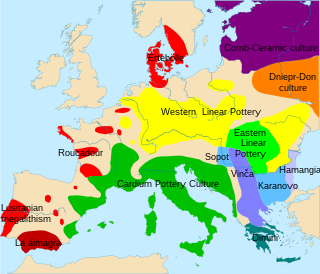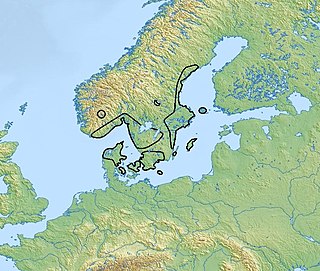 W
WThe Battle Axe culture, also called Boat Axe culture, is a Chalcolithic culture that flourished in the coastal areas of the south of the Scandinavian Peninsula and southwest Finland, from circa 2800 BC to circa 2300 BC.
 W
WThe Corded Ware culture comprises a broad archaeological horizon of Europe between ca. 2900 BCE – 2350 BCE, thus from the late Neolithic, through the Copper Age, and ending in the early Bronze Age. Corded Ware culture encompassed a vast area, from the contact zone between the Yamnaya culture and the Corded ware culture in south Central Europe, to the Rhine on the west and the Volga in the east, occupying parts of Northern Europe, Central Europe and Eastern Europe. The Corded Ware culture is thought to have originated from the westward migration of Yamnaya-related people from the steppe-forest zone into the territory of late Neolithic European cultures such as the Globular Amphora and Funnelbeaker cultures, and is considered to be a likely vector for the spread of some or all of the core Indo-European languages, excluding the Anatolian languages and Tocharian.
 W
WThe Ertebølle culture is the name of a hunter-gatherer and fisher, pottery-making culture dating to the end of the Mesolithic period. The culture was concentrated in Southern Scandinavia. It is named after the type site, a location in the small village of Ertebølle on Limfjorden in Danish Jutland. In the 1890s, the National Museum of Denmark excavated heaps of oyster shells there, mixed with mussels, snails, bones and bone, antler and flint artifacts, which were evaluated as kitchen middens, or refuse dumps. Accordingly, the culture is less commonly named the Kitchen Midden. As it is approximately identical to the Ellerbek culture of Schleswig-Holstein, the combined name, Ertebølle-Ellerbek is often used. The Ellerbek culture is named after a type site in Ellerbek, a community on the edge of Kiel, Germany.
 W
WThe Fosna/Hensbacka, were two very similar Late Palaeolithic/early Mesolithic cultures in Scandinavia, and are often subsumed under the name Fosna–Hensbacka culture. This complex includes the Komsa culture that, notwithstanding different types of tools, is also considered to be a part of the Fosna culture group. The main difference is that the Fosna/Komsa culture was distributed along the coast of Northern Norway, whereas the Hensbacka culture had a more eastern distribution along the coast of western Sweden; primarily in central Bohuslän to the north of Gothenburg. The Hensbacka culture evolved into the later Sandarna culture which is found along the coast of western Sweden.
 W
WThe Funnel(-neck-)beaker culture, in short TRB or TBK was an archaeological culture in north-central Europe. It developed as a technological merger of local neolithic and mesolithic techno-complexes between the lower Elbe and middle Vistula rivers. These predecessors were the Lengyel-influenced Stroke-ornamented ware culture (STK) groups/Late Lengyel and Baden-Boleráz in the southeast, Rössen groups in the southwest and the Ertebølle-Ellerbek groups in the north. The TrB introduced farming and husbandry as a major source of food to the pottery-using hunter-gatherers north of this line.
 W
WThe Hamburg culture or Hamburgian was a Late Upper Paleolithic culture of reindeer hunters in northwestern Europe during the last part of the Weichsel Glaciation beginning during the Bölling interstadial. Sites are found close to the ice caps of the time. They extend as far north as the Pomeranian ice margin.
 W
WMaglemosian is the name given to a culture of the early Mesolithic period in Northern Europe. In Scandinavia, the culture was succeeded by the Kongemose culture.
 W
WThe Nordic Bronze Age is a period of Scandinavian prehistory from c. 1700–500 BC.
 W
WThe Pitted Ware culture was a hunter-gatherer culture in southern Scandinavia, mainly along the coasts of Svealand, Götaland, Åland, north-eastern Denmark and southern Norway. Despite its Mesolithic economy, it is by convention classed as Neolithic, since it falls within the period in which farming reached Scandinavia. The Pitted Ware people were largely maritime hunters, and were engaged in lively trade with both the agricultural communities of the Scandinavian interior and other hunter-gatherers of the Baltic Sea.
 W
WThe Spir Mountain Cairns are two well preserved Bronze Age cairns in Ångermanland, Norrland, Sweden, built as graves and burial monuments, with burial cists interred. The ancient site is located at the top of the mountain Spirberget by Lake Mosjön in the Grundsunda parish, north of Örnsköldsvik at the High Coast in Ångermanland. The name Spirbergsrösena was introduced by archaeologist Carl L. Thunberg as a formal name concept for the site in 2014 before a public lecture on behalf of the Swedish National Heritage Board, in connection with that year's Swedish national "Archaeology Day".
 W
WIn Swedish prehistory, the Vendel Period appears between the Migration Period and the Viking Age. The name is taken from the rich boat inhumation cemetery at Vendel parish church, Uppland. This is a period with very little precious metal and few runic inscriptions, crammed between periods with abundant precious metal and inscriptions. Instead, the Vendel Period is extremely rich in animal art on copper-alloy objects. It is also known for guldgubbar, tiny embossed gold foil images, and ostentatious helmets with embossed decoration such as the one exported and found at Sutton Hoo in England.